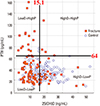1. Lips P. Vitamin D deficiency and secondary hyperparathyroidism in the elderly: consequences for bone loss and fractures and therapeutic implications. Endocr Rev. 2001; 22:477–501.

2. Kuchuk NO, Pluijm SM, van Schoor NM, et al. Relationships of serum 25-hydroxyvitamin D to bone mineral density and serum parathyroid hormone and markers of bone turnover in older persons. J Clin Endocrinol Metab. 2009; 94:1244–1250.

3. Rejnmark L, Vestergaard P, Brot C, et al. Parathyroid response to vitamin D insufficiency: relations to bone, body composition and to lifestyle characteristics. Clin Endocrinol (Oxf). 2008; 69:29–35.

4. Sahota O, Mundey MK, San P, et al. The relationship between vitamin D and parathyroid hormone: calcium homeostasis, bone turnover, and bone mineral density in postmenopausal women with established osteoporosis. Bone. 2004; 35:312–319.

5. Chapuy MC, Schott AM, Garnero P, et al. EPIDOS Study Group. Healthy elderly French women living at home have secondary hyperparathyroidism and high bone turnover in winter. J Clin Endocrinol Metab. 1996; 81:1129–1133.

6. Bakhtiyarova S, Lesnyak O, Kyznesova N, et al. Vitamin D status among patients with hip fracture and elderly control subjects in Yekaterinburg, Russia. Osteoporos Int. 2006; 17:441–446.

7. Holick MF. Vitamin D deficiency. N Engl J Med. 2007; 357:266–281.

8. Bi X, Tey SL, Leong C, et al. Prevalence of vitamin D deficiency in Singapore: Its implications to cardiovascular risk factors. PLoS One. 2016; 11:e0147616.

9. Jung IK. Prevalence of vitamin D deficiency in Korea: Results from KNHANES 2010 to 2011. J Nutr Health. 2013; 46:540–551.

10. Choi ES, Shon HC, Kim YM, et al. Is the incidence rate of hip fractures still increasing in Korea?: an epidemiologic study based on national health insurance database. J Korean Orthop Assoc. 2016; 51:447–454.

11. Suda T, Ueno Y, Fujii K, et al. Vitamin D and bone. J Cell Biochem. 2003; 88:259–266.

12. Teitelbaum SL. Bone resorption by osteoclasts. Science. 2000; 289:1504–1508.

13. Bischoff-Ferrari HA, Kiel DP, Dawson-Hughes B, et al. Dietary calcium and serum 25-hydroxyvitamin D status in relation to BMD among U.S. adults. J Bone Miner Res. 2009; 24:935–942.

14. Hannan MT, Litman HJ, Araujo AB, et al. Serum 25-hydroxyvitamin D and bone mineral density in a racially and ethnically diverse group of men. J Clin Endocrinol Metab. 2008; 93:40–46.

15. Kuchuk NO, van Schoor NM, Pluijm SM, et al. Vitamin D status, parathyroid function, bone turnover, and BMD in postmenopausal women with osteoporosis: global perspective. J Bone Miner Res. 2009; 24:693–701.

16. Hagström E, Lundgren E, Mallmin H, et al. Positive effect of parathyroidectomy on bone mineral density in mild asymptomatic primary hyperparathyroidism. J Intern Med. 2006; 259:191–198.

17. Jorde R, Sundsfjord J. Bone mineral density and blood pressure in patients with asymptomatic hyperparathyroidism. The Tromso Study. J Intern Med. 2000; 247:325–330.

18. Cummings SR, Nevitt MC, Browner WS, et al. Risk factors for hip fracture in white women. Study of Osteoporotic Fractures Research Group. N Engl J Med. 1995; 332:767–773.
19. Dhanwal DK, Sahoo S, Gautam VK, et al. Hip fracture patients in India have vitamin D deficiency and secondary hyperparathyroidism. Osteoporos Int. 2013; 24:553–557.

20. Larrosa M, Gomez A, Casado E, et al. Hypovitaminosis D as a risk factor of hip fracture severity. Osteoporos Int. 2012; 23:607–614.

21. Sakuma M, Endo N, Oinuma T, et al. Vitamin D and intact PTH status in patients with hip fracture. Osteoporos Int. 2006; 17:1608–1614.

22. Sahota O, Gaynor K, Harwood RH, et al. Hypovitaminosis D and ‘functional hypoparathyroidism’-the NoNoF (Nottingham Neck of Femur) study. Age Ageing. 2001; 30:467–472.

23. Melhus H, Snellman G, Gedeborg R, et al. Plasma 25-hydroxyvitamin D levels and fracture risk in a community-based cohort of elderly men in Sweden. J Clin Endocrinol Metab. 2010; 95:2637–2645.

24. Yamauchi M, Kaji H, Nawata K, et al. Role of parathyroid hormone in bone fragility of postmenopausal women with vitamin D insufficiency. Calcif Tissue Int. 2011; 88:362–369.

25. Amouzougan A, Chopin F, Laporte S, et al. Functional hypoparathyroidism in postmenopausal women with fragility fracture. Joint Bone Spine. 2012; 79:170–175.

26. Kim H, Ahn SH, Shin C, et al. The association of higher plasma macrophage migration inhibitory factor levels with lower bone mineral density and higher bone turnover rate in postmenopausal women. Endocrinol Metab (Seoul). 2016; 31:454–461.

27. Lips P, Duong T, Oleksik A, et al. A global study of vitamin D status and parathyroid function in postmenopausal women with osteoporosis: baseline data from the multiple outcomes of raloxifene evaluation clinical trial. J Clin Endocrinol Metab. 2001; 86:1212–1221.

28. Mosekilde L. Primary hyperparathyroidism and the skeleton. Clin Endocrinol (Oxf). 2008; 69:1–19.

29. Rejnmark L, Vestergaard P, Brot C, et al. Increased fracture risk in normocalcemic postmenopausal women with high parathyroid hormone levels: a 16-year follow-up study. Calcif Tissue Int. 2011; 88:238–245.

30. Sikjaer T, Rolighed L, Hess A, et al. Effects of PTH(1-84) therapy on muscle function and quality of life in hypoparathyroidism: results from a randomized controlled trial. Osteoporos Int. 2014; 25:1717–1726.

31. Gielen E, O'Neill TW, Pye SR, et al. Endocrine determinants of incident sarcopenia in middle-aged and elderly European men. J Cachexia Sarcopenia Muscle. 2015; 6:242–252.

32. Renoud A, Ecochard R, Marchand F, et al. Predictive parameters of accelerated muscle loss in men-MINOS study. Am J Med. 2014; 127:554–561.

33. Serhan E, Newton P, Ali HA, et al. Prevalence of hypovitaminosis D in Indo-Asian patients attending a rheumatology clinic. Bone. 1999; 25:609–611.

34. Holick MF. High prevalence of vitamin D inadequacy and implications for health. Mayo Clin Proc. 2006; 81:353–373.

35. Malabanan A, Veronikis IE, Holick MF. Redefining vitamin D insufficiency. Lancet. 1998; 351:805–806.

36. Thomas MK, Lloyd-Jones DM, Thadhani RI, et al. Hypovitaminosis D in medical inpatients. N Engl J Med. 1998; 338:777–783.








 PDF
PDF ePub
ePub Citation
Citation Print
Print



 XML Download
XML Download